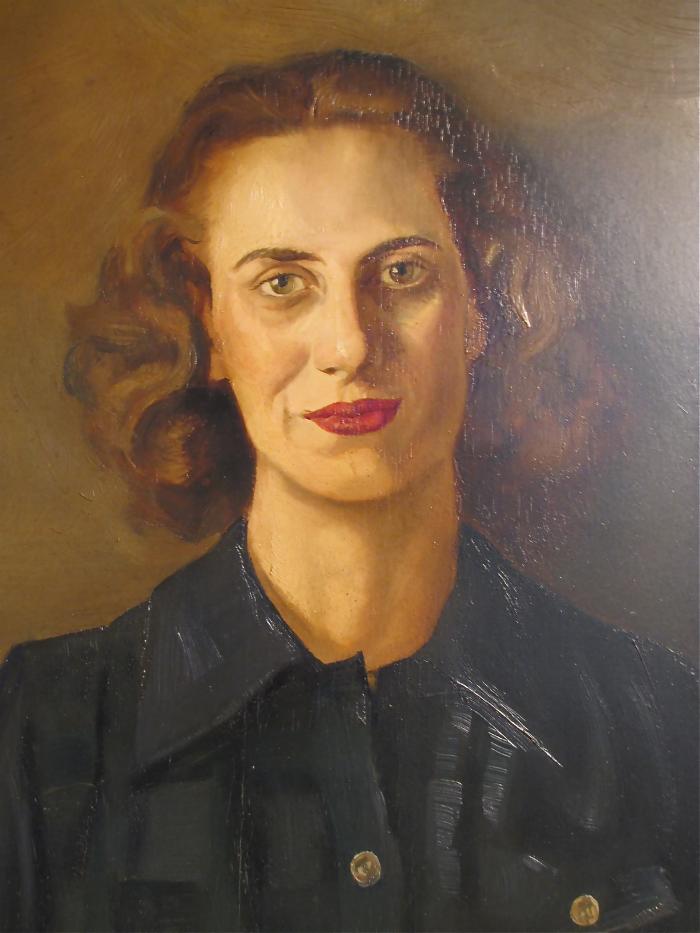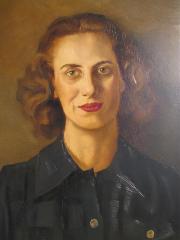Meanwhile, Armand, now twenty-three, had not forgotten the girl in high school that stopped him in his tracks. He asked her for a date. Betty remembers their first date when she was seventeen. “It poured rain and my hair was just, you know, hanging in strings. I thought, ‘Oh, I’ll never see him again.’ But he called again. Then again, and on the third date he asked me to marry him. It was just as though it was meant to be. I knew it and he knew it. It was sort of an intuitive, made in heaven thing.”
Her mother had one of these old rectangular wicker baskets [on legs] that you put flower pots in. Ya, I remember that because of the night of the big vow, the gift, you know, the agreement, the ring. We got home from a movie and by gosh, it was bulging in my pocket in that box, and I jammed it into the fern box until after her folks went to bed. (hearty, mischievous laugh). I wanted some privacy about presenting that (giggle) right there in a fern box, Ya.
When Armand bought an engagement ring for Betty, he insisted on buying the best and borrowed to do it. When the stone was displayed at the Merizon home, the reaction of Armand’s mother and sisters showed that the pragmatic standard still dogged him. “You had better not let [brother] Frank see that,” they agreed (VanderMey, 2012).
In Betty Granger Armand had found a devoted soul mate. He recalls their courtship. “I never dreamt that someday I would be throwing stones at the upper window of that house well after midnight when I was out for a late walk in the summer, just to have her raise the window.”
Fearing trouble, she’d whisper down to him in a gruff voice, “’Will you stop that! You’re going to wake up my folks.’
He shot back, ‘How about Friday night?’
She responded, ‘Alright, you go home and get to bed.’
Then I’d walk home in the dark with a big grin on my face” (Dornbush/Zandstra Interview, 6-14-04).
Although they became engaged in 1944 on their third date, their marriage was delayed six years until Betty’s father felt Armand could make enough money to provide for her. Betty was removed from Armand by a double barrier––– coming from a financially secure home and having been raised as a Christian Scientist. But the barriers fell after a few meetings. Armand realized that here was a woman of quality with an almost angelic inner beauty and a rare steadfastness. As for Betty, she managed to look past Armand’s tumultuous energies and his current insecurities, drawn to what she felt was his extraordinary talent along with his unfailing honesty and strength of character.
During their engagement and at an age when most men had homes and families of their own, Armand lived with his parents on Bates Street. He continued painting and often sat outside the Civic Auditorium, easel ready on symphony nights, hoping to earn enough from sketching twenty-five-cent portraits to afford a ticket for himself. During this time he also accepted commissioned work painting portraits for locally prominent individuals and submitted paintings for the covers of national outdoor magazines. In 1944 one of his paintings was accepted for the cover of Field and Stream Magazine. During this time he was also able to hold a one-man show at the St. Cecelia building. These recognitions enabled him to land a half day job teaching design at Kendall Arts School while also working part time in a printing shop.
In 1946 he took stock and decided that he needed more schooling in the art of composition. Hence he enrolled in the New York Phoenix School of Design. The GI Bill paid for classes and he lived at the YMCA on borrowed money. He breezed through most of the courses but was challenged by the composition class, knowing already then that the composition of any given painting controlled what one painted and how one painted it. Armand recalled, “I had in art school an excellent teacher who said you can take one house, one barn, one casual building and one tree. We had to work them into a composition. Sounds simple. I’m telling you I had to work a week to get that whole thing to behave! How do you construct the architecture of the shape and placement of everything there, the rhythm of the lines, the spacing, the proportion of everything. And think of values, where you have light and dark. Then of course the color by itself - - you know. Color by itself is a language all unto itself” (Dornbush/Zandstra Interview, 7-10-02). Years later, in a speech Armand stated, “The composition, the unseen, is supposed to be there in evidence, but not noticed for itself as an end in itself. Composition is hard to pinpoint. Poor composition may give us an unpleasant feeling, but we may not be aware what it is that’s bothering us” (Merizon, “The Psychology of Composition,” 4-13-89). Although the assignments were difficult, his teacher frequently singled out Armand’s work as a model for others.
Merizon believed that composition is something that had taken him years to understand clearly. He believed you don’t just try to get the subject well represented, but you try to have it of a pleasing shape and form to the onlooker. If you try to talk about it to an art class, it’s pretty hard, dry stuff– mathematical. It’s just pure intellectual analysis.
The composition justifies the shape and proportion that you’re working on. It’s completely arbitrary whether it’s a square, a rectangle, vertical or horizontal, but it’s abnormal to the human eye to have 45 or 90 degree corners. The human eye doesn’t see that way. We have a center of interest and a gradual fading out to the edges.






